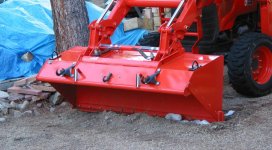At altitude the pressure differential across the exhaust turbine is greater since atmospheric pressure is lower. As a result the turbine spins a little faster and compresses a bit more air on the intake side. It does not completely make up for the lower atmospheric pressure at the intake due to turbine losses. But it's a lot closer than naturally aspirated.
Advantages | BorgWarner Turbo Systems
Boosting With Altitude - How Elevation Affects Turbochargers
OK, I can't resist posting about the other side of turbo madness.
Open up any new tractor sales brochure and the sales people really push the "turbo advantage". But is it really an advantage? I do agree with part of it....Yes, like BorgWarner says in the link Eric posted above, the power to weight ratio is better for the turbocharged engine. I'll give them that.
And we know that especially at high altitude we can turbo-charge an engine to largely make up for the power lost if we were using that same engine in its naturally-aspirated form (i.e. no turbo).
Of course we only care about that missing power when we are using the naturally-aspirated motor at full throttle and need more power. Otherwise, you'd just open the throttle a little more and never miss the lack of a turbo. Which leads us down an interesting path.....
There are other ways to solve the loss of power at altutude. In fact the simplest way of all is simply to start with a larger dieel engine in the first place. Power to weight ratio isn't a magic formula. It's a ratio that counts for a lot in race cars and airplanes, but we have tractors. And in our tractor we WANT extra weight. Why not put that extra weight in the form of an engine? Tractors can make good use of weight for more traction, strength, and reliability too. In fact, tractors may be unique in that there is a definite working advantage to the old fashioned heavy diesel featuring high torque at low rpm of the cooler running, slow-turning, quiet, naturally-aspirated diesel engine. As opposed to a smaller, lighter, turbocharged and high-revving diesel engine. Who wants a screamer? Not to speak of the advantage of mechanical simplicity.
And one more thing to think about: There are some engines out there designed with a turbo-charger AND an EGR valve. Well, shucks.....Add a turbo and an EGR and one pretty much negates the other powerwise - especially at high rpm plus the mechanical complication is doubled. How is that an advantage??
Why a turbo AND and EGR? Why would any engine designer want to densify the incoming charge by taking hot corrosive exhaust gases and using a turbo to mix those already-burnt out exhaust gases into the fresh air of the next combustion cycle? Inexpensive pollution control?
rScotty
BTW, I'm not biased...well, not too much. Half of our tractors have turbos. And they are the ones we use every day.

